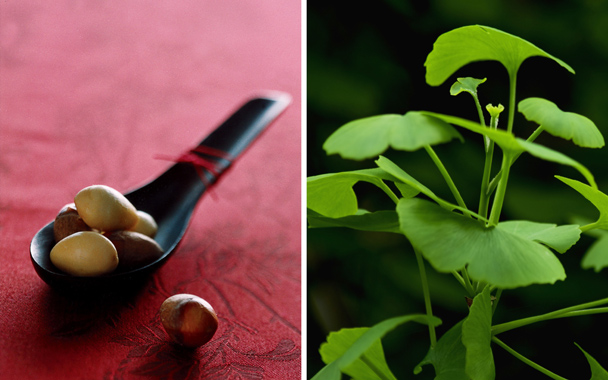During these autumn days in Manhattan’s West Village, you can’t consume anything more local than a ginkgo nut (unless you count the remnants of your window box of kitchen herbs). The nuts are speckling the sidewalks of our tree-lined streets, and they’re carpeting the ground under our park benches. Your child may have stomped on them, and your dog has probably considered eating them. But you, no matter how dedicated you are to eating seasonally and locally, understandably avoid each year’s ginkgo crop as if it were a rotten offering from the compost heap.
The female ginkgo tree’s fruit, which houses the gingko nut, has been called “nature’s stink bomb,” with an assaulting stench that’s often compared to rancid butter, funky cheese, wet dog, or vomit. The butyric acid in ginkgo fruits—which is what makes them so smelly (it is also found in butter, parmesan cheese, and vomit)—is supposed to keep animals from eating the fallen fruit of this ancient Asian tree. But since local and seasonal eating is basically a hobby for my husband and me, I decided to go beyond the tri-state-grown veggies at the farmer’s market or the heritage-breed pork we covet from upstate. Like an Appalachian farm girl sent up the holler for some ramps, I faced the stink and went out gathering in Washington Square Park.
The week before, I’d seen several older Asian visitors to the park filling plastic bags with the mushy, pale, cherry-sized fruit. Ginkgo nuts are fairly common in Chinese, Japanese, and Korean cooking. Contact with the fruit itself can cause a poison ivy-like reaction, and several websites advise wearing latex gloves during collection and handling; however, all of the clearly veteran gatherers I’d witnessed were bare-handed, so I too shirked this precaution. I regretted this almost immediately: Before my plastic bag was halfway full, I slunk away, not because I was overwhelmed by the smell, but because the fruits were so soggy that, no matter how daintily I picked them up, they usually collapsed in my grasp, like overly supple pieces of rot.
I spent that afternoon in Chinatown, hoping to learn some local preparation tips for this local ingredient. Many people peered into my plastic bag and, after stiffly withdrawing from its stench, dispensed advice. An energetic, middle-aged cashier at Best Goody Food Corporation said that it’s too much work harvesting the nuts from the fruit. “They taste like nothing,” she told me, and then, slicing her hand through the air with finality, added, “No taste!” A very patient man at Ken On Tong Herbs Inc. on Mott Street bravely took one of the fruits out of the bag, and pinched it open to show me the ginkgo nut’s pistachio-sized shell. His fingers coated with the fruit’s yellow, smelly flesh, he explained that Chinese cooks use the shelled nuts in desserts and in an Asian rice porridge with meat or fish. On the Bowery, at Congee Chinese Restaurant, the manager didn’t speak much English, but the plastic bag (which was a sagging swampy mess by that point) communicated enough. A cluster of employees gathered around. The hostess spoke high-speed Cantonese at the bag. A Latino dishwasher took a whiff and laughed. A cook in a white apron and hat suggested, through the manager’s rough translation, that, sure, after a lot of smelly heartache and work, I could make a simple soup, but why not just chuck the offensive things in the trash and use the canned ginkgo nuts he used for the restaurant’s dried scallop and ginkgo nut congee? I tied the plastic bag closed and ordered the congee, a liquidy grits-like offering in which my novice palate couldn’t distinguish anything like the chestnut or edamame taste the ginkgo nut is said to have.
Then I went home to perform the task that would define just how dedicated I was to taking local and seasonal eating to the extreme: I rummaged through the stinky stew in the plastic bag until I’d extracted a nut from each of the gag-inducing fruits. I overcame several waves of nausea, I burped and winced, and, on one of the last fruits, I sneezed loudly enough to jerk my dog awake from his nap. I scrubbed the nuts and left them drying on a paper towel. Then, in an effort to try to distract myself from how bad my hands smelled, I decided to call a couple of Manhattan’s top chefs to find out what they thought of ginkgo nuts.




 Pinterest
Pinterest


